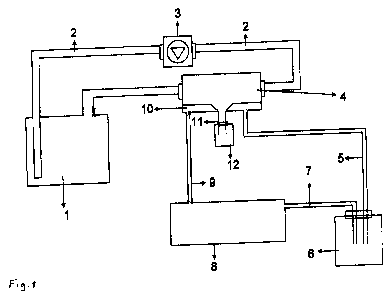Some of the information on this Web page has been provided by external sources. The Government of Canada is not responsible for the accuracy, reliability or currency of the information supplied by external sources. Users wishing to rely upon this information should consult directly with the source of the information. Content provided by external sources is not subject to official languages, privacy and accessibility requirements.
Any discrepancies in the text and image of the Claims and Abstract are due to differing posting times. Text of the Claims and Abstract are posted:
| (12) Patent Application: | (11) CA 2742749 |
|---|---|
| (54) English Title: | METHOD FOR CLEANING TANKS |
| (54) French Title: | PROCEDE DE NETTOYAGE DE CUVES |
| Status: | Deemed Abandoned and Beyond the Period of Reinstatement - Pending Response to Notice of Disregarded Communication |
| (51) International Patent Classification (IPC): |
|
|---|---|
| (72) Inventors : |
|
| (73) Owners : |
|
| (71) Applicants : |
|
| (74) Agent: | SMART & BIGGAR LP |
| (74) Associate agent: | |
| (45) Issued: | |
| (86) PCT Filing Date: | 2009-11-05 |
| (87) Open to Public Inspection: | 2010-05-14 |
| Availability of licence: | N/A |
| Dedicated to the Public: | N/A |
| (25) Language of filing: | English |
| Patent Cooperation Treaty (PCT): | Yes |
|---|---|
| (86) PCT Filing Number: | PCT/EP2009/008004 |
| (87) International Publication Number: | WO 2010052020 |
| (85) National Entry: | 2011-05-04 |
| (30) Application Priority Data: | ||||||
|---|---|---|---|---|---|---|
|
Method and apparatus for removing residues of hazardous materials from vapour
in a tank (1), wherein such a
vapour is heated, passed outside the tank and subsequently cooled and the
remaining dry vapour is recirculated, characterized in
that a) said vapour is heated to a temperature of at least 5°C above
the melting point and below the self ignition point of the hazardous
material, b) the vapour mixture thus formed is passed by means of a pump (3)
from the tank through a discharge unit to a
recovery unit, c) is cooled to a temperature of at least 5°C lower and
above the melting point of the hazardous material in a recovery
unit, d) the liquid components of the vapour are recovered and the dry gas
mixture is recirculated to the tank after reheating to
the desired temperature, e) said recirculation being repeated as required.
<IMG>
Procédé et dispositif dextraction de résidus de substances dangereuses de la vapeur présente dans une cuve (1) consistant à chauffer la vapeur, à lextraire du réservoir, puis à la refroidir, et à réintroduire la vapeur sèche restante. Ce procédé est caractérisé en ce que a) la vapeur est chauffée à une température dau moins 5°C au-dessus du point de fusion, mais au-dessous du point dauto-allumage de la substance dangereuse dans lunité de récupération, b) le mélange de vapeur ainsi formé est transféré au moyen dune pompe (3) de la cuve via une unité de décharge dans une unité de récupération, c) la vapeur est refroidie dau moins 5°C, mais à une température supérieure au point de fusion de la substance dangereuse dans lunité de récupération, d) les composants liquides de la vapeur et le mélange de gaz sec sont récupérés et réintroduits dans la cuve après un nouveau chauffage à la température requise et e) lopération de réintroduction est répétée au besoin.
Note: Claims are shown in the official language in which they were submitted.
Note: Descriptions are shown in the official language in which they were submitted.

2024-08-01:As part of the Next Generation Patents (NGP) transition, the Canadian Patents Database (CPD) now contains a more detailed Event History, which replicates the Event Log of our new back-office solution.
Please note that "Inactive:" events refers to events no longer in use in our new back-office solution.
For a clearer understanding of the status of the application/patent presented on this page, the site Disclaimer , as well as the definitions for Patent , Event History , Maintenance Fee and Payment History should be consulted.
| Description | Date |
|---|---|
| Application Not Reinstated by Deadline | 2014-11-05 |
| Time Limit for Reversal Expired | 2014-11-05 |
| Deemed Abandoned - Failure to Respond to Maintenance Fee Notice | 2013-11-05 |
| Letter Sent | 2011-08-02 |
| Inactive: Single transfer | 2011-07-14 |
| Inactive: Cover page published | 2011-07-11 |
| Inactive: Notice - National entry - No RFE | 2011-06-28 |
| Inactive: IPC assigned | 2011-06-27 |
| Inactive: IPC assigned | 2011-06-27 |
| Inactive: IPC assigned | 2011-06-27 |
| Inactive: First IPC assigned | 2011-06-27 |
| Application Received - PCT | 2011-06-27 |
| National Entry Requirements Determined Compliant | 2011-05-04 |
| Application Published (Open to Public Inspection) | 2010-05-14 |
| Abandonment Date | Reason | Reinstatement Date |
|---|---|---|
| 2013-11-05 |
The last payment was received on 2012-10-12
Note : If the full payment has not been received on or before the date indicated, a further fee may be required which may be one of the following
Please refer to the CIPO Patent Fees web page to see all current fee amounts.
| Fee Type | Anniversary Year | Due Date | Paid Date |
|---|---|---|---|
| Basic national fee - standard | 2011-05-04 | ||
| Registration of a document | 2011-07-14 | ||
| MF (application, 2nd anniv.) - standard | 02 | 2011-11-07 | 2011-10-28 |
| MF (application, 3rd anniv.) - standard | 03 | 2012-11-05 | 2012-10-12 |
Note: Records showing the ownership history in alphabetical order.
| Current Owners on Record |
|---|
| THE EUROPEAN INNOVATION GROUP B.V. |
| Past Owners on Record |
|---|
| PERRY VAN DER BOGT |